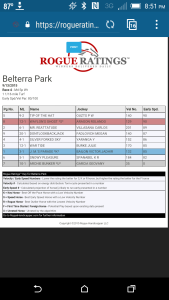Another simple beauty to the Rogue Ratings™ computer program is that it outlines for You the new fan or novice handicapper the projected race shape in a “visually representation.” Which is key, because new fans have to abstractly put the race together in their heads and that is not easy at all. As the new fan or novice handicapper lacks experience to correctly judge how a race looks to shape up.
The program page lists the horses in order of which horses are projected to run early, mid or late in a race from top to bottom and it’s just that simple! Now, if you want to know the exact early speed number specifically for each horse then just look under the column listed as Early Spd.(Early Speed) and you will see the early speed number which starts with the highest early speed number at the top of the program page and runs to the lowest early speed number at the bottom of the program page.
By looking quickly at the horses from top to bottom of the program page a new fan or novice horseplayer can easily see, know and learn the projected race shape very fast which in turn helps to increase their learning of the game!
 “From The Rail” blog features Hal Wafer the Rogue Handicapper®, giving you insightful analysis of the Rogue Ratings™ computer program for races coast-to-coast to help the new fan, novice handicapper and seasoned gambler's to master the Rogue Ratings App and doing it all, "Right Out of the Gate"! Also, the Rogue Handicapper® gives you an insider's view of the game from daily handicapping at the track, handicapping tournaments and industry topics. The Rogue Handicapper® will present new and contrarian ideas to help grow and attract new fans and novice horseplayers to this great game!
“From The Rail” blog features Hal Wafer the Rogue Handicapper®, giving you insightful analysis of the Rogue Ratings™ computer program for races coast-to-coast to help the new fan, novice handicapper and seasoned gambler's to master the Rogue Ratings App and doing it all, "Right Out of the Gate"! Also, the Rogue Handicapper® gives you an insider's view of the game from daily handicapping at the track, handicapping tournaments and industry topics. The Rogue Handicapper® will present new and contrarian ideas to help grow and attract new fans and novice horseplayers to this great game!






Follow RogueHandicapper